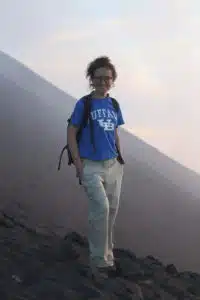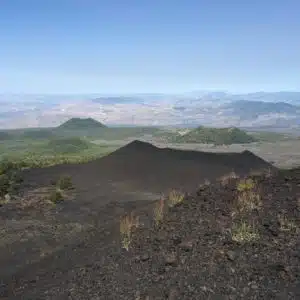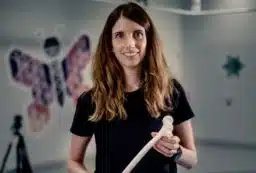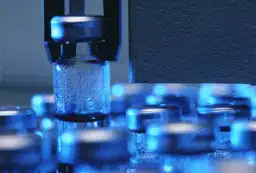Tiny crystals, which can be as small as a grain of salt, that form deep in volcanoes have revealed a potential time-warning system for volcanic eruptions.
“This could signal good news for the almost one in 10 people around the world who live within 100 kilometres of an active volcano,” says University of Queensland volcanologist Dr Teresa Ubide.
“We haven’t yet reached the ‘holy grail’ of being able to predict volcanic eruptions, but our research means a significant step forward in the understanding of the processes that lead to eruption.”
Dr Ubide used a new laser technique to study the composition of tiny crystals that formed deep in Mt Etna, Europe’s most active volcano. Her work is being published today (23 January 2018) in Nature Communications.
When molten rock (magma) forms deep underneath a volcano and starts to move upwards, it creates special crystals.
These tiny crystals grow up to 30 kilometres underground and move upwards in erupting magma, continuing to crystallise and change in composition on the way to the surface.
“The tiny crystals effectively ‘record’ the processes that happen deep in the volcano right before the eruption starts,” says Dr Ubide.
“We’ve found by studying these crystals in a specific volcano that, up to 90 per cent of the time when new magma arrives in the volcano, it can trigger an eruption within two weeks.”
From such information, volcanologists can work out how to better monitor volcanoes before they erupt – for instance, what depths underground to look at for signs of movement.
Understanding why, how and when volcanic eruptions start will improve monitoring of volcanic activity in the future, allowing more effective evacuations and communication.
Currently, it is very difficult to predict volcanic eruptions – as evidenced by the eruption at Mount Agung in Bali, which started last November after two months of earthquakes. It led to the evacuation of over 70,000 people and caused massive disruptions in air traffic and tourism, affecting over 100,000 travellers.
Every volcano is a little different and requires individual study and monitoring.
Volcanologists measure changes in earthquakes, temperature, gas release, and ground deformations to try to predict eruptions using tools like sensors, cameras, infrared, and satellite imaging.
Dr Ubide’s team tracked eruptions, their triggers and time scales at Mount Etna (Sicily, Italy). This should inform future volcanic monitoring efforts at Mount Etna.
“We plan to apply the same approach to other volcanoes around the world, especially for countries in our neighbouring region, like Indonesia and New Zealand,” she says.
“The ability of the crystals to record the history of eruptions has not been explored in such detail before, and our new knowledge offers a step forward in being better able to predict likely volcanic eruptions.”
Dr Ubide won this year’s Fresh Science People’s Choice Award (Southeast Queensland) for her work – the competition is national, and helps early-career researchers find and share their stories of discovery.
The program takes up-and-coming researchers with no media experience and turns them into spokespeople for science, giving them a taste of life in the limelight, with a day of media training and a public event in their home state.
Fresh Science Southeast Queensland is presented by Science in Public, Econnect Communication, the Queensland Government, Queensland University of Technology, the University of Queensland, Griffith University, and the University of the Sunshine Coast.
…/ENDS
For interview
Dr Teresa Ubide, School of Earth and Environmental Sciences, The University of Queensland, t.ubide@uq.edu.au, phone 0403 334 152, (0)7 3365 2677
Media contact
Jenni Metcalfe, Econnect Communication (for Fresh Science), jenni@econnect.com.au, phone 0408 551 866
Katie Rowney, The University of Queensland, katie.rowney@uq.edu.au, phone 07 3365 3439
Photos
Video clips
The University of Queensland has made two video clips where Theresa talks about her work. Videos include footage of Mt Etna erupting as well as Theresa working in the lab on her crystals:







 Fresh Science is on hold for 2022. We will be back in 2023.
Fresh Science is on hold for 2022. We will be back in 2023.